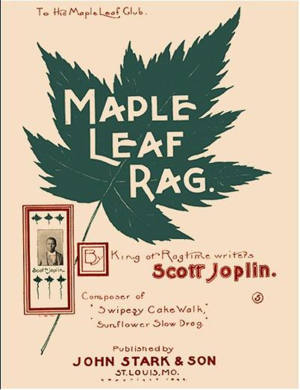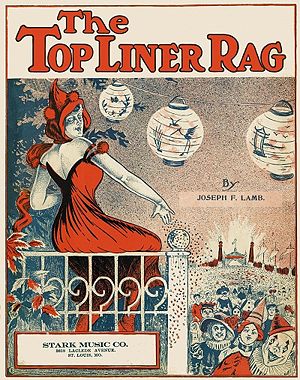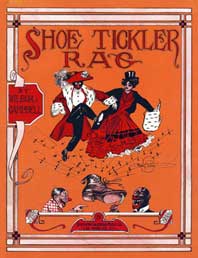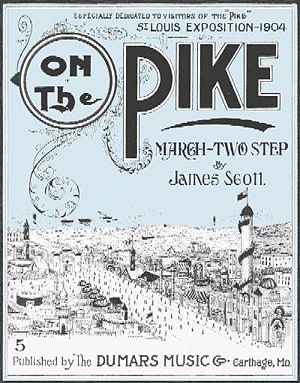Ragtime
2008/9 Schools Wikipedia Selection. Related subjects: Musical genres, styles, eras and events
| Ragtime (music) | |
| Stylistic origins |
Cakewalk, Jig, March
|
|---|---|
| Cultural origins |
1890s: US
|
| Typical instruments | |
| Mainstream popularity | 1900s, 1910s |
| Derivative forms | Stride, Novelty piano |
| Fusion genres | |
| Jazz | |
Ragtime (alternately spelled Rag-time) is an American musical genre which enjoyed its peak popularity between 1897 and 1918. It has had several periods of revival since then and is still being composed today. Ragtime was the first truly American musical genre, predating jazz. It began as dance music in popular music settings years before being published as popular sheet music for piano. Being a modification of the then popular march, it was usually written in 2/4 or 4/4 time (meter) with a predominant left hand pattern of bass notes on odd-numbered beats and chords on even-numbered beats accompanying a syncopated melody in the right hand. A composition in this style is called a "rag". A rag written in 3/4 time is a "ragtime waltz".
Ragtime is not a "time" ( meter) in the same sense that march time is 2/4 meter and waltz time is 3/4 meter; it is rather a musical genre that uses an effect that can be applied to any meter. The defining characteristic of ragtime music is a specific type of syncopation in which melodic accents occur between metrical beats. This results in a melody that seems to be avoiding some metrical beats of the accompaniment by emphasizing notes that either anticipate or follow the beat. The ultimate (and intended) effect on the listener is actually to accentuate the beat, thereby inducing the listener to move to the music. Scott Joplin, the composer/pianist known as the "King of Ragtime", called the effect "weird and intoxicating". He also used the term "swing" in describing how to play ragtime music: "Play slowly until you catch the swing...". The name swing later came to be applied to an early genre of jazz that developed from ragtime. Converting a non-ragtime piece of music into ragtime by changing the time values of melody notes is known as "ragging" the piece. Original ragtime pieces usually contain several distinct themes, four being the most common number.
According to the New Grove Dictionary of Jazz the musical form was originally called "ragged time" which was elided to "ragtime" ( elision).
Historical context
Ragtime originated in African American musical communities, in the late 19th century, and descended from the jigs and marches played by all-black bands common in all Northern cities with black populations. By the start of the 20th century it became widely popular throughout North America and was listened and danced to, performed, and written by people of many different subcultures. A distinctly American musical style, ragtime may be considered a synthesis of African syncopation and European classical music, though this description is oversimplified.
Some early piano rags are entitled marches, and "jig" and "rag" were used interchangeably in the mid-1890s and ragtime was also preceded by its close relative the cakewalk. In 1895, black entertainer Ernest Hogan published two of the earliest sheet music rags, one of which ("All Coons Look Alike to Me") eventually sold a million copies. As fellow Black musician Tom Fletcher said, Hogan was the "first to put on paper the kind of rhythm that was being played by non-reading musicians." While the song's success helped introduce the country to ragtime rhythms, its use of racial slurs created a number of derogatory imitation tunes, known as " coon songs" because of their use of extremely racist and stereotypical images of blacks. In Hogan's later years he admitted shame and a sense of "race betrayal" for the song while also expressing pride in helping bring ragtime to a larger audience.
The emergence of mature ragtime is usually dated to 1897, the year in which several important early rags were published. In 1899, Scott Joplin's Maple Leaf Rag was published, which became a great hit and demonstrated more depth and sophistication than earlier ragtime. Ragtime was one of the main influences on the early development of jazz (along with the blues). Some artists, like Jelly Roll Morton, were present and performed both ragtime and jazz styles during the period the two genres overlapped. Jazz largely surpassed ragtime in mainstream popularity in the early 1920s, although ragtime compositions continue to be written up to the present, and periodic revivals of popular interest in ragtime occurred in the 1950s and the 1970s.
Some authorities consider ragtime to be a form of classical music. The heyday of ragtime predated the widespread availability of sound recording. Like classical music, and unlike jazz, classical ragtime was and is primarily a written tradition, being distributed in sheet music rather than through recordings or by imitation of live performances. Ragtime music was also distributed via piano rolls for player pianos. A folk ragtime tradition also existed before and during the period of classical ragtime (a designation largely created by Scott Joplin's publisher John Stark), manifesting itself mostly through string bands, banjo and mandolin clubs (which experienced a burst of popularity during the early 20th Century), and the like.
A form known as novelty piano (or novelty ragtime) emerged as the traditional rag was fading in popularity. Where traditional ragtime depended on amateur pianists and sheet music sales, the novelty rag took advantage of new advances in piano-roll technology and the phonograph record to permit a more complex, pyrotechnic, performance-oriented style of rag to be heard. Chief among the novelty rag composers is Zez Confrey, whose "Kitten on the Keys" popularized the style in 1921.
Ragtime also served as the roots for stride piano, a more improvisational piano style popular in the 1920s and 1930s. Elements of ragtime found their way into much of the American popular music of the early 20th century. It also played a central role in the development of the musical style later referred to as " Piedmont blues;" indeed, much of the music played by such artists of the genre, such as Reverend Gary Davis, Blind Boy Fuller, Elizabeth Cotten, and Etta Baker, could be referred to as "ragtime guitar."
Although most ragtime was composed for piano, transcriptions for other instruments and ensembles are common, notably including Gunther Schuller's arrangements of Joplin's rags. Occasionally ragtime was originally scored for ensembles (particularly dance bands and brass bands), or as songs. Joplin had long-standing ambitions for a synthesis of the worlds of ragtime and opera, to which end the opera Treemonisha was written; but it was never performed in his lifetime. In fact the score was lost for decades, then rediscovered in 1970; it has been performed in numerous productions since then. An earlier opera by Joplin, A Guest of Honour, has been lost.
Styles of ragtime
Ragtime pieces came in a number of different styles during the years of its popularity and appeared under a number of different descriptive names. It is related to several earlier styles of music, has close ties with later styles of music, and was associated with a few musical " fads" of the period such as the foxtrot. Many of the terms associated with ragtime have inexact definitions, and are defined differently by different experts; the definitions are muddled further by the fact that publishers often labelled pieces for the fad of the moment rather than the true style of the composition. There is even disagreement about the term "ragtime" itself; experts such as David Jasen and Trebor Tichenor choose to exclude ragtime songs from the definition but include novelty piano and stride piano (a modern perspective), while Edward A. Berlin includes ragtime songs and excludes the later styles (which is closer to how ragtime was viewed originally). Many ragtime pianists, Eubie Blake and Mark Birnbaum among them, include the songs and the later styles as ragtime. The terms below should not be considered exact, but merely an attempt to pin down the general meaning of the concept.
- Cakewalk - A pre-ragtime dance form popular until about 1904. The music is intended to be representative of an African-American dance contest in which the prize is a cake. Many early rags are cakewalks.
- Characteristic march - A march incorporating idiomatic touches (such as syncopation) supposedly characteristic of the race of their subject, which is usually African-Americans. Many early rags are characteristic marches.
- Two-step - A pre-ragtime dance form popular until about 1911. A large number of rags are two-steps.
- Slow drag - Another dance form associated with early ragtime. A modest number of rags are slow drags.
- Coon song - A pre-ragtime vocal form popular until about 1901. A song with crude, racist lyrics often sung by white performers in blackface. Gradually died out in favour of the ragtime song. Strongly associated with ragtime in its day, it is one of the things that gave ragtime a bad name.
- Ragtime song - The vocal form of ragtime, more generic in theme than the coon song. Though this was the form of music most commonly considered "ragtime" in its day, many people today prefer to put it in the "popular music" category. Irving Berlin was the most commercially successful composer of ragtime songs, and his " Alexander's Ragtime Band" (1911) was the single most widely performed and recorded piece of this sort, even though it contains virtually no ragtime syncopation. Gene Greene was a famous singer in this style.
- Folk ragtime - A name often used to describe ragtime that originated from small towns or assembled from folk strains, or at least sounded as if they did. Folk rags often have unusual chromatic features typical of composers with non-standard training.
- Classic rag - A name used to describe the Missouri-style ragtime popularized by Scott Joplin, James Scott, and others.
- Fox-trot - A dance fad which began in 1913. Fox-trots contain a dotted-note rhythm different from that of ragtime, but which nonetheless was incorporated into many late rags.
- Novelty piano - A piano composition emphasizing speed and complexity which emerged after World War I. It is almost exclusively the domain of white composers.
- Stride piano - A style of piano which emerged after World War I, developed by and dominated by black East coast pianists ( James P. Johnson, Fats Waller and Willie 'The Lion' Smith). Together with novelty piano, it may be considered a successor to ragtime, but is not considered by all to be "genuine" ragtime. Johnson composed the song that is arguably most associated with the Roaring Twenties, "Charleston." A recording of Johnson playing the song appears on the compact disc, James P. Johnson: Harlem Stride Piano (Jazz Archives No. 111, EPM, Paris, 1997). Johnson's recorded version has a ragtime flavor.
Ragtime revivals
In the early 1940s many jazz bands began to include ragtime in their repertoire and put out ragtime recordings on 78 RPM records. Old numbers written for piano were rescored for jazz instruments by jazz musicians, which gave the old style a new sound. The most famous recording of this period is Pee Wee Hunt's version of Euday L. Bowman's Twelfth Street Rag.
A more significant revival occurred in the 1950s. A wider variety of ragtime styles of the past were made available on records, and new rags were composed, published, and recorded. Much of the ragtime recorded in this period is presented in a light-hearted novelty style, looked to with nostalgia as the product of a supposedly more innocent time. A number of popular recordings featured "prepared pianos," playing rags on pianos with tacks on the keys and the instrument deliberately somewhat out of tune, supposedly to simulate the sound of a piano in an old honky tonk.
Three events brought forward a different kind of ragtime revival in the 1970s. First, pianist Joshua Rifkin brought out a compilation of Scott Joplin's work on Nonesuch Records, which was nominated for a Grammy in the "Best Classical Performance - Instrumental Soloist(s) without Orchestra" category in 1971. This recording reintroduced Joplin's music to the public in the manner the composer had intended, not as a nostalgic stereotype but as serious, respectable music. Second, the New York Public Library released a two-volume set of "The Collected Works of Scott Joplin," which renewed interest in Joplin among musicians and prompted new stagings of Joplin's opera Treemonisha. Finally, with the release of the motion picture The Sting in 1973, which had a Marvin Hamlisch soundtrack of Joplin tunes, ragtime was brought to a wide audience. Hamlisch's rendering of Joplin's 1902 rag The Entertainer was a top 40 hit in 1974.
In 1998, an adaption of E.L. Doctorow's historic novel, Ragtime was produced on Broadway. With music by Stephen Flaherty and lyrics by Lynn Ahrens, the show featured several rags as well as songs in other musical genres.
In modern times, younger musicians have again begun to find ragtime, and incorporate it into their musical repertoires. Such acts include The Kitchen Syncopators, Inkwell Rhythm Makers, The Gallus Brothers and the not-quite as young Baby Gramps.
Ragtime composers
By far the most famous ragtime composer was Scott Joplin. Joseph Lamb and James Scott are, together with Joplin, acknowledged as the three most sophisticated ragtime composers. Some rank Artie Matthews as belonging with this distinguished company. Other notable ragtime composers included May Aufderheide, Eubie Blake, George Botsford, Zez Confrey, Ben Harney, Charles L. Johnson, Luckey Roberts, Paul Sarebresole, Wilbur Sweatman, and Tom Turpin.
Modern ragtime composers include William Bolcom, William Albright, David Thomas Roberts, Frank French, Trebor Tichenor, Mark Birnbaum, Reginald R. Robinson, John Roache, Tom Brier, and Warren Trachtman.
Quotations
"There are a great many colored people who are ashamed of the cake-walk, but I think they ought to be proud of it. It is my opinion that the colored people of this country have done four things which refute the oft-advanced theory that they are an absolutely inferior race, which demonstrate that they have originality and artistic conception, and, what is more, the power of creating that which can influence and appeal universally. The first two of these are the Uncle Remus stories, collected by Joel Chandler Harris, and the Jubilee songs, to which the Fisk singers made the public and the skilled musicians of both America and Europe listen. The other two are ragtime music and the cake-walk. No one who has traveled can question the world-conquering influence of ragtime, and I do not think it would be an exaggeration to say that in Europe the United States is popularly known better by ragtime than by anything else it has produced in a generation. In Paris they call it American music."
James Weldon Johnson: The Autobiography of an Ex-Colored Man, 1912.




